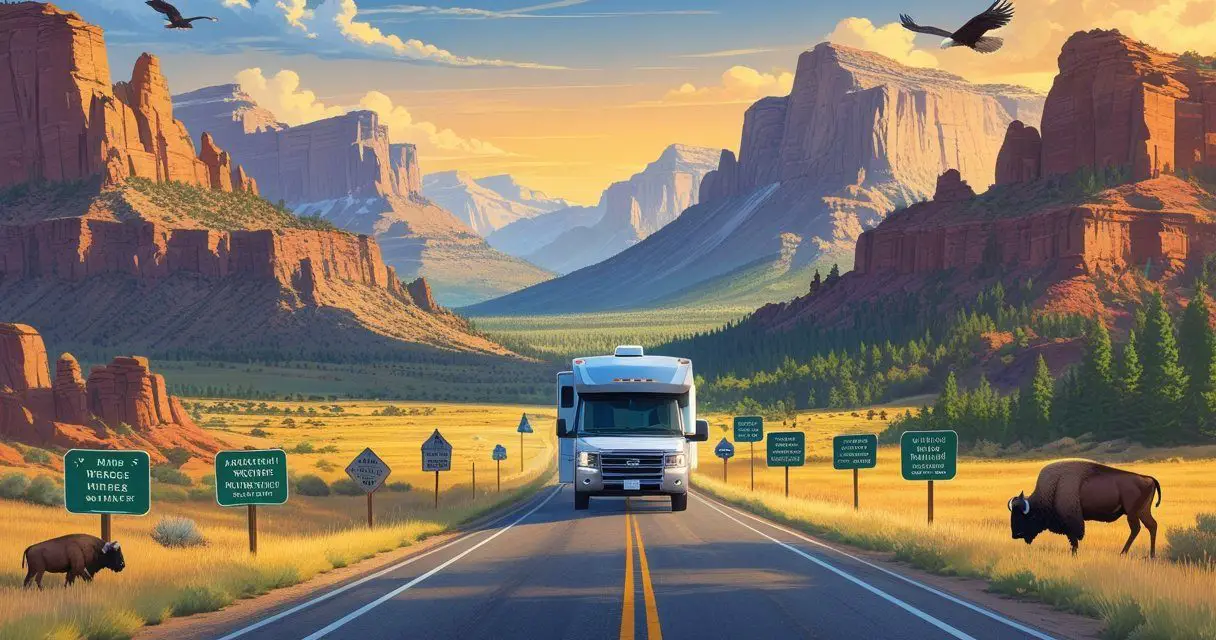Would you like to save this article?
America’s National Historic Trails offer RV travelers a unique way to explore the country’s rich past while enjoying modern comfort and convenience. These trails follow the paths of early explorers, pioneers, and Native Americans who shaped the nation’s history. RV enthusiasts can experience these historic routes through well-preserved trail segments, interpretive centers, and campgrounds designed specifically for recreational vehicles.
From coast to coast, these historic trails wind through diverse landscapes and tell stories of westward expansion, cultural exchange, and human perseverance. Many trails feature RV-friendly facilities and educational stops that bring history to life. Each trail offers its own character, from desert crossings to mountain passes, providing travelers with both historical insight and scenic beauty along the way.
1) California National Historic Trail
The California National Historic Trail spans over 5,000 miles across 10 states. More than 250,000 emigrants traveled this route during the 1840s and 1850s.
This trail represents the largest mass migration in American history. Most travelers headed west seeking gold and fertile farmland in California.
RV travelers can still see over 1,000 miles of original wagon ruts today. These traces show where pioneers once crossed the American West.
The trail offers museums and visitor centers along the route. Many sites provide educational programs about pioneer life and western expansion.
Gold discovery at Sutter’s Fort in 1849 sparked the famous California Gold Rush. This event brought thousands more people along the trail.
Interactive maps help visitors find specific locations to explore. The trail crosses multiple states from the Missouri River to California’s Central Valley.
Modern RV campgrounds sit near many historic trail sites. Travelers can camp close to the same areas where wagon trains once stopped.
The National Park Service maintains trail markers and interpretive sites. These help visitors understand the challenges pioneers faced during their journey west.
2) Oregon National Historic Trail
The Oregon National Historic Trail stretches over 2,100 miles from Missouri to Oregon. It ranks as one of the longest units in the National Park System.
Between 1840 and 1860, an estimated 300,000 to 400,000 people made this four-month journey west. The trail originally served as an Indian route for foot and horseback travel.
By the 1840s, the route had widened to accommodate covered wagon trains. Traders, mountain men, and fur trappers used this path in the early 1800s.
More than 2,000 miles of trail ruts and traces remain visible today across six states. These markings serve as reminders of early American settlers’ experiences.
RV travelers can drive alongside the trail heading northwest through wide-open fields. The Oregon Trail Scenic Byway follows the main route from the Snake River crossing near Glenns Ferry to Bonneville Point.
Oregon Trail Park at Scott Springs commemorates an old emigrant camping ground. Visitors can explore numerous locations along the historic route and walk sections of the original path.
The National Historic Oregon Trail Interpretive Center offers detailed maps and exhibits. Fort Vancouver National Historic Site provides additional historical context as a former fur trading outpost.
3) Santa Fe National Historic Trail
The Santa Fe National Historic Trail stretches over 1,200 miles across five states. The trail runs from Franklin, Missouri to Santa Fe, New Mexico.
Travelers pass through Missouri, Kansas, Oklahoma, Colorado, and New Mexico. This historic route was a major commercial highway between 1821 and 1880.
RV travelers can follow the Santa Fe Trail National Scenic Byway. The highway route roughly follows the original trail path through Kansas, southeast Colorado, and northern New Mexico.
The trail crosses through homelands of many Indigenous peoples. These lands hold cultural significance and remain important to the communities who have stewarded them for generations.
Spring and fall offer the best weather conditions for visiting. These seasons typically have pleasant temperatures and fewer crowds.
The National Park Service manages the trail today. Visitors can explore historic sites, museums, and landmarks along the route.
RV travelers should research historic sites in advance. Planning helps prioritize stops and create a better itinerary for the journey.
The trail connects travelers to an important piece of American and Mexican trade history. It served as an international commercial highway until 1846.
4) Lewis and Clark National Historic Trail
The Lewis and Clark National Historic Trail stretches nearly 4,900 miles across the United States. It follows the path of the famous expedition from 1803 to 1806.
The trail starts in Pittsburgh, Pennsylvania and ends at the Pacific Ocean. It passes through the homelands of more than 60 tribal nations.
RV travelers can follow designated driving routes that connect historical sites and visitor centers. The National Park Service provides detailed maps and guides for the journey.
A complete trip along the trail takes about one month. This depends on how many stops travelers make at natural and historical sites.
The trail offers incredible mountain views and scenic landscapes. Visitors can see the Lemhi Valley and surrounding mountain ranges in some areas.
Many sections include visitor centers with exhibits about the expedition. These centers help explain the complex history of Lewis and Clark’s journey.
The trail connects multiple states and diverse landscapes. Travelers experience rivers, plains, mountains, and forests along the route.
RV camping is available at many locations along the trail. State parks and campgrounds provide convenient stopping points for extended trips.
5) El Camino Real de Tierra Adentro
El Camino Real de Tierra Adentro is America’s oldest Euro-American trade route. This historic trail connected Mexico City to New Mexico over 300 years ago.
The trail spans 1,600 miles total, with 404 miles running through the United States. It crosses through New Mexico and represents three centuries of cultural exchange.
RV travelers can explore museums, interpretive centers, and historic sites along the route. Many locations offer information about the trail’s complex history of conflict and cooperation between different empires.
The trail includes Spanish colonial missions that show how Spain settled new territories. These sites provide insight into the historic mission system and early American settlement patterns.
Visitors should pack comfortable walking shoes and outdoor clothing. The trail passes through natural landscapes, rural areas, and small towns with limited facilities.
The National Park Service and Bureau of Land Management jointly manage this trail. It became part of the National Trails System in 2000.
A typical visit can range from a few hours to a full day. Travelers should check local weather conditions and contact sites beforehand for current hours and fees.
6) Old Spanish National Historic Trail
The Old Spanish National Historic Trail stretches 1,200 miles from Santa Fe, New Mexico, to Los Angeles, California. This historic route crosses six western states including Arizona, Colorado, Nevada, and Utah.
New Mexican traders used this trail in the mid-1800s to transport goods by mule pack trains. They traded local merchandise for horses and mules from California settlements.
The trail passes through diverse landscapes including deserts, mountains, and canyonlands. Spanish explorers first used parts of this route in the early 1600s to connect their settlements.
RV travelers should know this is not a continuous marked trail. The route passes through communities, wilderness areas, and different land ownerships across multiple states.
The National Park Service and Bureau of Land Management jointly protect important sites along the trail. Visitors can use a mobile map that provides information about points of interest.
Planning is essential for any visit. RV travelers need to research specific sections, check weather conditions, and pack adequate supplies including food, water, and emergency equipment.
The trail offers a unique glimpse into southwestern trading history and the cultural interactions between Native Americans, Spanish explorers, and Mexican traders.
7) Mormon Pioneer National Historic Trail
The Mormon Pioneer National Historic Trail stretches 1,300 miles across five states. It follows the route taken by Brigham Young and thousands of Mormon pioneers from 1846 to 1869.
The trail begins in Nauvoo, Illinois and ends in Salt Lake City, Utah. Over 70,000 Mormons traveled this path to escape religious persecution and reach the Great Salt Lake Valley.
Large portions of the trail follow the Oregon and California Trails. The route passes through challenging terrain and extreme weather conditions that tested the pioneers’ determination.
RV travelers can explore historical sites along the trail’s path. The final 75-mile stretch from Wyoming to Salt Lake City offers dozens of significant landmarks and interpretive locations.
Visitors can bike, hike, camp, and photograph along various sections. The trail provides multiple ways to experience this important chapter in American westward expansion.
The route crosses through Wyoming and Utah, offering stunning landscapes. Each section tells the story of the Mormon migration and their journey to establish new communities in the West.
This historic trail combines outdoor adventure with American history. It provides insight into the challenges faced by religious groups seeking freedom in the 1800s.
8) Trail of Tears National Historic Trail
The Trail of Tears National Historic Trail stretches over 2,200 miles across nine states. It runs through North Carolina, Georgia, Tennessee, Alabama, Kentucky, Illinois, Missouri, Arkansas, and Oklahoma.
This trail remembers the forced removal of over 16,000 Cherokee people in 1838 and 1839. The federal government made them leave their homelands and walk to Oklahoma. Other tribes also suffered this same fate.
RV travelers can visit many sites along the trail route. Each state offers different historic locations and landmarks to explore. The trail has over 100 places where visitors can learn about this important history.
Planning ahead helps RV trips go smoothly on this trail. Travelers should research which sections they want to visit before starting their journey. The trail covers a lot of ground across many states.
The Cherokee Nation website provides helpful information about the Cherokee people.
9) Nevada National Historic Trail
Nevada offers RV travelers access to multiple historic trails that cross the state from east to west. The California National Historic Trail and Pony Express National Historic Trail both pass through Nevada’s diverse landscape.
RV enthusiasts can follow the Auto Tour Routes designed specifically for these trails. Site-by-site driving directions make navigation simple for larger vehicles.
The Historic Railroad Tunnel Trail near Lake Mead provides a unique experience. This 3.7-mile trail from Hoover Dam offers views of the lake while following historic railroad routes.
Trail segments wind through desert terrain and mountain passes. Historic sites along the routes mark important stopping points used by early travelers and mail carriers.
Interactive maps help visitors locate museums and interpretive centers throughout Nevada. These facilities provide information about the trails’ historical significance.
The trails follow routes of exploration and migration from America’s expansion period. RV travelers can park at designated areas and explore on foot or by bike.
Nevada’s portion of these historic trails connects to trail segments in neighboring states. This allows for extended RV trips following the complete historic routes across multiple states.
Planning an RV Adventure on National Historic Trails
Planning a successful RV trip along historic trails requires careful timing and preparation. Peak travel seasons vary by region, while proper equipment and route planning ensure a safe journey across long distances.
Choosing the Best Trail Season
Spring and fall offer the best weather for most historic trails. These seasons provide comfortable temperatures and fewer crowds at popular stops.
The Lewis and Clark Trail works best from May through September. Winter weather in Montana and North Dakota can be harsh for RV travel.
Oregon Trail RVers should plan trips between April and October. Mountain passes may close during winter months. Summer brings hot desert conditions in Wyoming and Nevada.
The Civil Rights Trail offers year-round travel opportunities. Southern states have mild winters. Summer heat and humidity can be uncomfortable but manageable with air conditioning.
Trail of Tears routes are ideal from March through May and September through November. This timing avoids both winter ice and summer heat waves across multiple states.
Essential RV Tips for Long-Distance Travel
Check your RV’s systems before departure. Test brakes, tires, electrical connections, and water systems. Long historic trails put extra stress on equipment.
Plan fuel stops every 200-300 miles. Historic routes often pass through rural areas with limited gas stations. Download apps that locate RV-friendly fuel stops.
Research campground availability along your route. Many historic trail areas have limited RV parks. Make reservations at least two weeks in advance during peak season.
Pack emergency supplies including extra water, food, and basic tools. Cell phone coverage can be spotty on remote trail sections. Carry paper maps as backup navigation.
Preserving History and Natural Beauty
Historic trails require careful protection to maintain their cultural significance and natural landscapes for future generations. RV travelers play a crucial role in conservation efforts through respectful behavior and responsible camping practices.
Respecting Cultural Heritage Sites
Many National Historic Trails cross Indigenous lands with deep cultural importance. These areas often contain sacred sites, burial grounds, and artifacts that need protection.
Visitors should stay on designated paths and avoid disturbing historical markers or remnants. Taking artifacts or souvenirs damages these irreplaceable resources.
Key respectful practices include:
- Following posted signs and barriers
- Not climbing on historical structures
- Keeping noise levels low at sacred sites
- Photographing responsibly without flash on delicate materials
The Bureau of Land Management acknowledges the complex history these trails represent. This includes stories of removal, violence, and broken treaties that shaped the American landscape.
RV travelers should educate themselves about local tribal history before visiting. Many visitor centers offer cultural programs led by Indigenous guides.
Minimizing Environmental Impact While RVing
Large RVs can damage fragile trail ecosystems if not managed properly. Staying in designated campgrounds protects vegetation and wildlife habitats along historic routes.
Essential low-impact camping practices:
- Use established campsites only
- Dump waste water at proper facilities
- Pack out all trash and recyclables
- Keep generators quiet during designated hours
Water conservation becomes critical in desert trail sections like parts of the Old Spanish Trail. RV travelers should carry extra water rather than using natural sources.
Wildlife encounters require special care along historic corridors. Store food in sealed containers and maintain safe distances from animals to preserve natural behaviors.





